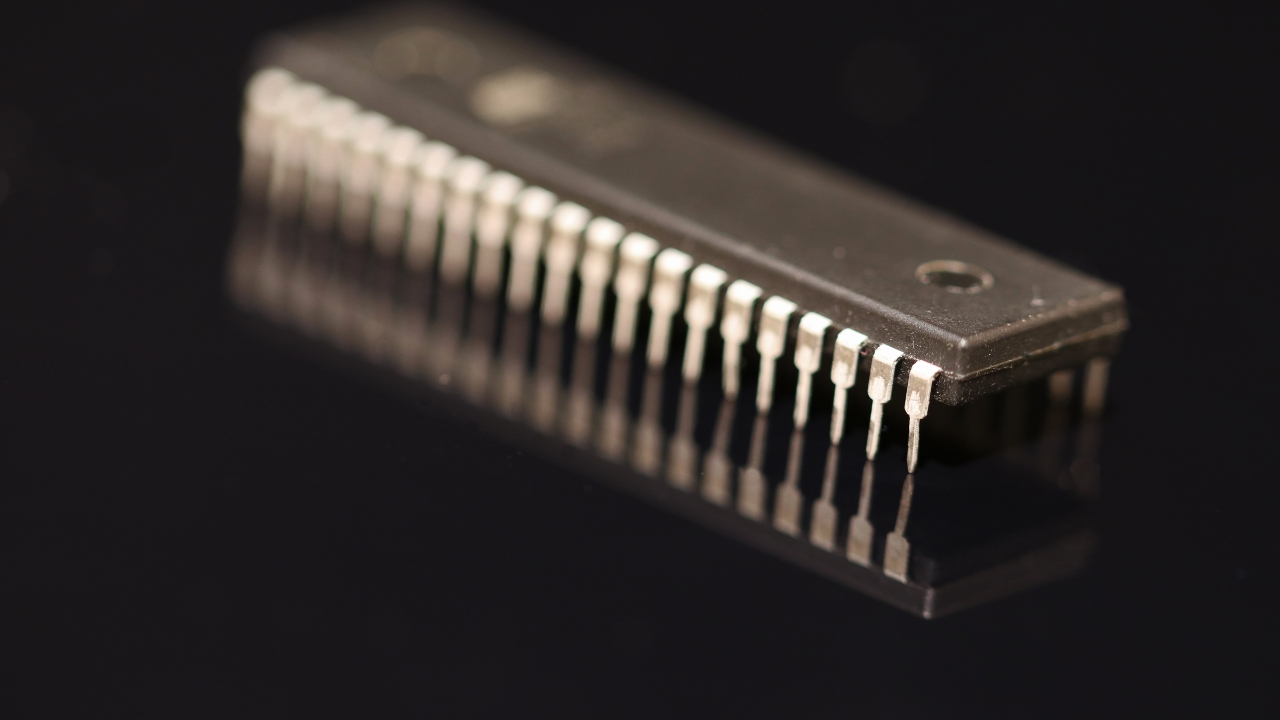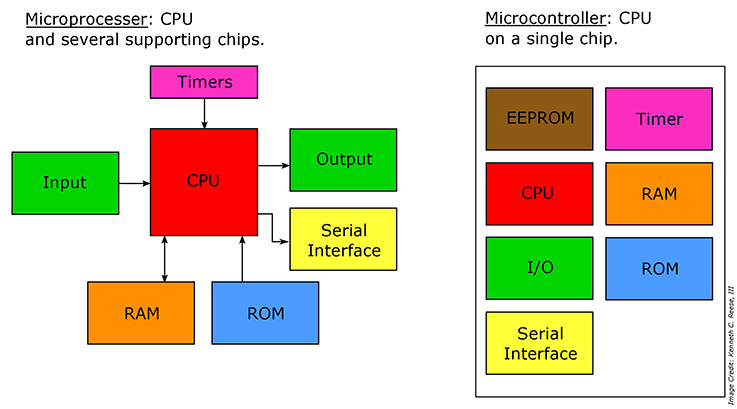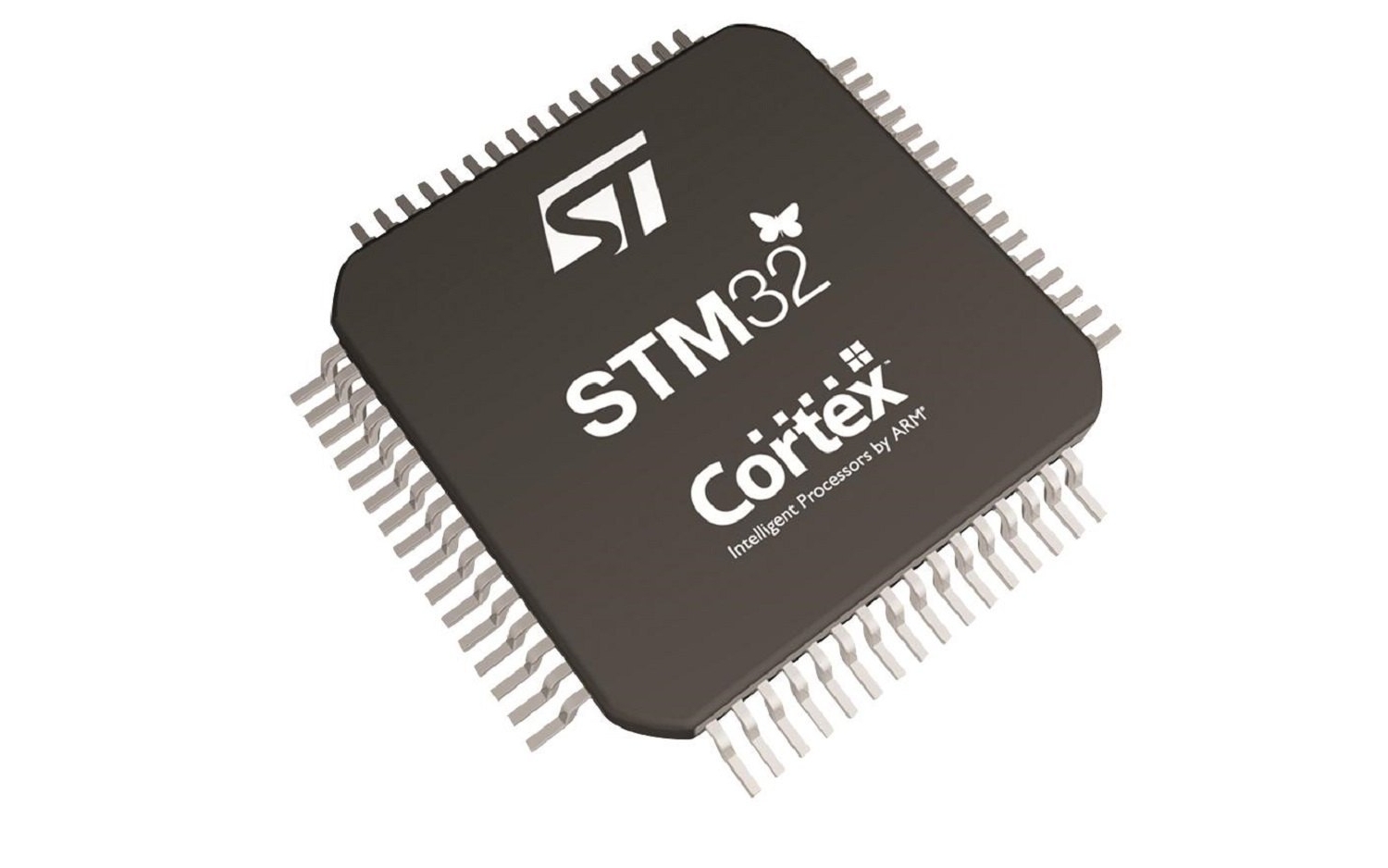
A multitude of development boards that we use frequently, from the Arduino itself to many others, use MCU units or microcontrollers. Some vital chips to be able program these devices and that the instructions created by the programmer can be processed to obtain the expected results.
However, The microcontroller sector is quite broad., as is also the case with CPUs or microprocessors, since not only are there many designers or manufacturers, as well as models, but there are also many different families that you should know. So, we are going to dedicate this article to this very thing, so that you know which one might interest you the most for your projects…
What is a microcontroller or MCU?
Un microcontroller or MCU (MicroController Unit) It is a compact device that integrates the functions of a central processor (CPU), memory and peripherals on a single chip. This device is the centerpiece of many electronic systems and is fundamental in the field of embedded electronics. In short, a great alternative to wired electronics, thus allowing a single chip to perform a multitude of functions flexibly, since it is programmable.
Microcontrollers are used in a wide variety of applications due to its versatility and efficiency. Some examples of use for microcontrollers include control systems in automobiles, home appliances, industrial automation systems, process control systems, toys, security systems, development boards, and many other electronic equipment.
Parts of microcontrollers
Microcontrollers are integrated devices, and all their components are implemented on a chip or integrated circuit. Between the most fundamental parts of these chips are:
- CPU (Central Processing Unit): The central processing unit is the brain of the microcontroller, and its most important part. This unit is responsible for using the data and instructions of the program to interpret and process them appropriately in the execution units to obtain the expected results. That is, the CPU carries out all calculation operations and makes decisions based on the program logic. The speed and efficiency of the CPU largely determines the performance of the microcontroller. In addition, they also usually have elementary parts such as interrupt systems, which allow the microcontroller to respond to certain events in a timely manner. When a specific event occurs, such as a signal input or a timer reaching a specific value, the microcontroller can interrupt its current task to respond to this event.
- Conference proceedings: They usually have two types of memory such as RAM and flash. RAM memory is used to store temporary data, such as the instructions that make up the programs and the data (variables, constants,...) during the execution of the program. While flash memory is used to store the program to be executed, and it is non-volatile like RAM, so when the power is interrupted or the device is turned off, the program will remain.
- Input/Output Peripherals (I/O): allow the microcontroller to interact with the outside world. These may include digital I/O ports, analog-to-digital converters (ADC), digital-to-analog converters (DAC), communication interfaces such as UART, SPI, and I2C, variety controllers, timers, counters, GPIO, and others.
How is it different from a microprocessor or CPU?
A microprocessor and a microcontroller are two fundamental components in the field of electronics, but they have significant differences in terms of structure and use, even though many people confuse the two or believe they are the same.
While the CPU only integrates functional units for the control and interpretation of instructions, registers, as well as execution instructions such as the ALU, FPU, etc., and can be combined with other auxiliary elements in a more flexible way, microcontrollers are somewhat more closed in the sense of that integrate many of the parts that the CPU leaves out. In fact, while the CPU is the brain of a computer, the MCU can be considered a complete computer, since it includes all the basic parts on a single chip.
However, do not confuse greater integration with terms of complexity and performance. While current microprocessors are extremely complex and with very high performance, current microcontrollers usually have an integrated CPU with much lower and simpler performance. In fact, many of today's microcontrollers can have performance similar to microprocessors from decades ago. What's more, as we will see later, we even have 8-bit or 16-bit microcontrollers like the CPUs of the 70s.
Differences compared to an SoC?
Since the microcontroller integrates several elements on the same chip, It is also often confused with the SoC (System on a Chip)However, it is not the same either. As with the CPU vs MCU, SoCs also integrate a CPU with much higher performance than most current microcontrollers. Furthermore, the SoC is an infinitely more complex and advanced system. On the other hand, the SoC does not usually integrate some of the parts that are integrated into a microcontroller, since the applications for which it is intended do not require it, such as RAM and flash memory, ADC converters, etc.
A Little History
Early multi-circuit microprocessors, such as the AL1 from Four-Phase Systems in 1969 and the MP944 from Garrett AiResearch in 1970, were developed with multiple MOS LSI chips. The first single-chip microprocessor was the Intel 4004, released in 1971. These processors required several external chips to implement a functional system, which was expensive. However, almost in parallel, what we know today as a microcontroller was developed. HE attributed to IT engineers, Gary Boone and Michael Cochran, the successful creation of the first microcontroller in 1971, the TMS 1000, which combined read-only memory, read/write memory, processor and clock on a single chip. In fact, although this is another story, it generated a patent war and lawsuits over the authorship of the microprocessor...
During the 1970s, the Japanese electronics manufacturers began producing microcontrollers for automobiles. They gradually became popular, and in response to the existence of the single-chip TMS 1000, Intel developed a computer system on a chip optimized for control applications, the Intel 8048, which combined RAM and ROM on the same chip along with a CPU. With the passage of time, non-volatile memories were improved, and went from being recorded at the factory with a permanent program like the first ROMs until the introduction of the PROM, or the EEPROM of 1993, which allowed it to be erased and reprogrammed with another program in a simple way and as many times as you want.
Little by little, companies were born around this type of chips, such as Atmel, Microchip Technology, and many others. Other companies in the sector also began to distribute their own MCUs, such as Intel, Analog Devices, Cypress, AMD, ARM, Hitachi, EPSON, Motorola, Zilog, Infineon, Lattice, National Semiconductor, NEC, Panasonic, Renesas, Rockell, Sony, STMicroelectronics , Synopsis, Toshiba, etc.
Today, microcontrollers are cheap and easily accessible to hobbyists and a multitude of different industrial sectors. Furthermore, it is estimated that they are sold almost 5 billion 8-bit units worldwide, being the most used currently. You can find them in household appliances, vehicles, computers, phones, industrial machines, and much more. Furthermore, they have managed to miniaturize to the maximum, creating some of the smallest computers in the world, even much smaller than a grain of salt...
ISA and microcontroller families
Now that you know a little more about what an MCU or microcontroller is, let's see some of the most important families of these microcontrollers. And, like CPUs, they can be divided according to the ISA, that is, the repertoire of instructions, registers and data types that are used, and the compatibility of the binary programs that can be executed will depend on this. making them not compatible between families. And these families are totally independent of the model, brand or units included in the chip.
Among the latests Moravia's compositions most popular families we have the following:
- Children: is a generation of softcores for FPGAs from Altera, now absorbed by Intel.
- Blackfin: is a family of 16/32-bit microprocessors developed, manufactured and marketed by Analog Devices. The processors also have built-in digital signal processor (DSP) functionality, performed by 16-bit multiplication-accumulation (MAC).
- TigerSHARC: stands for Super Harvard Architecture Single-Chip Computer, also from Analog Devices. In this case they are ideal for applications that require high computing performance with low power consumption. These processors offer a unique memory architecture that enables efficient access to data and instructions without the performance penalty associated with Von Neumann bus architectures.
- Cortex-M- ARM's Cortex-M microcontrollers are a popular family of 32-bit microcontrollers that are very power efficient and offer good performance. They are especially popular in industrial and consumer applications, and currently represent the majority of modern chips sold by many companies.
- APR32: It is a 32-bit RISC microcontroller architecture produced by Atmel, and you can find it on many development boards, such as Arduino and clones of it.
- RISC-V: This open ISA aims to surpass ARM, and little by little it has begun to have importance in the world of microcontrollers, since it is very flexible and allows its use without paying royalties.
- PIC- are a family of 8-bit microcontrollers developed by Microchip Technology, known for their advanced RISC architecture, and are quite popular in the industry.
- PowerQUICC: are based on IBM's Power Architecture technology, and were used by Motorola (now Freescale), they support the full spectrum of embedded network equipment, industrial and general embedded applications.
- expansion: These are Fujitsu's MCUs, and are focused on analog and digital products, and designed for efficiency and balanced performance.
- 8051: It is an 8-bit microcontroller developed by Intel, although you will now find it manufactured by other companies as well. It is one of the most popular microcontrollers and is used in a wide range of applications. The 8051 is a CISC microcontroller based on the Harvard architecture.
- TriCore: is a microcontroller developed by Infineon Technologies. TriCore unites the elements of a RISC processor core, a microcontroller, and a DSP on a single chip. At the time it was a revolution.
- MC-48 or 8048: It is a microcontroller from the Intel line, with 64 bytes of RAM and access to 4096 bytes of external program memory.
- Mico8- is an 8-bit microcontroller family implemented entirely in general-purpose memory and logic for Lattice FPGAs.
- Propeller: 32-bit multicore architecture developed by Parallax Inc. Each Propeller has 8 identical 32-bit processors connected to a common hub.
- Basic Stamp- is a microcontroller with a small specialized BASIC interpreter (PBASIC) built into the ROM. It is manufactured by Parallax, Inc, and was a quite popular product for makers who wanted to do a multitude of projects at home before Arduino was released.
- Super H: is a 32-bit RISC computing instruction set architecture developed by Hitachi and currently produced by Renesas, and focused on microcontrollers for embedded systems.
- tiva: is a series microcontroller developed by Texas Instruments. It has a built-in processor clock frequency of up to 80MHz with a floating point unit (FPU), with great performance.
- Microblaze: is a highly integrated processor system intended for controller applications. MicroBlaze is implemented entirely in the memory and general-purpose logic of Xilinx (now AMD) FPGAs, that is, a softcore.
- Picoblaze: similar to the previous one, but in this case it is 8-bit and simpler, for more integrated applications.
- XCore: They are XMOS multicore MCUs, 32 bits that are programmed in a C language environment and operate deterministically and with low latency. They are very complete and can be implemented in the form of tiles.
- Z8: is from Zilog, and they are 8-bit devices that offer a wide range of performance and resource options. These microcontrollers are ideal for high-volume, cost-sensitive applications, including consumer, automotive, security, and HVAC products.
- Z180: It is another of the popular ones within Zilog before the release of the new eZ that have updated the previous ranges. It includes an 8-bit processor, compatible with the large software base written for the Z80. The Z180 family adds higher performance and integrated peripheral features such as clock generator, 16-bit counters/timers, interrupt controller, wait state generators, serial ports, and a DMA controller.
- STM: This STMicroelectronics family has some MCU units based on this company's own architecture, although in the latest models it has been chosen, as in many other cases, to integrate 32-bit ARM Cortex-M Series. It offers products that combine very high performance, real-time capabilities, digital signal processing, low-power/low-voltage operation and connectivity, while maintaining complete integration and ease of development.
There are more, but these are the most important…

